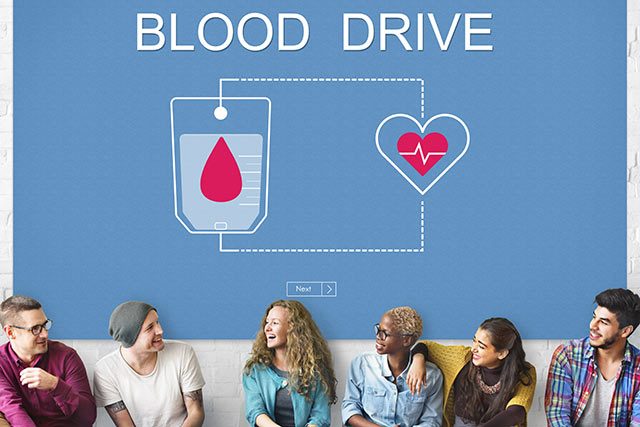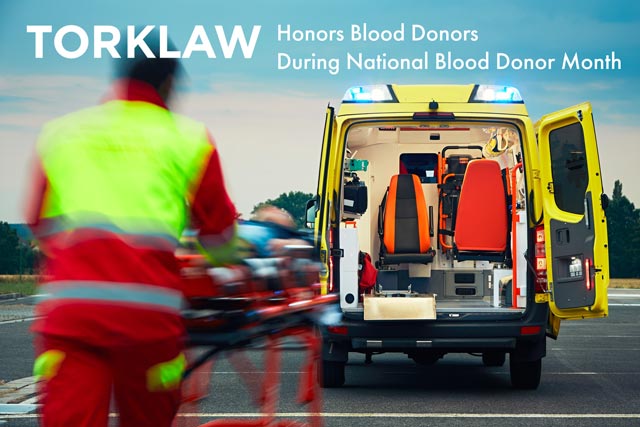According to the American Red Cross, someone in our country needs blood every two seconds, and this blood must come from volunteer donors. January is National Blood Donor Month, to celebrate those who donate their blood to help others.
If you are one of the 6.8 million people donate blood in the United States each year, TorkLaw thanks you.
However, only 10% of eligible individuals give blood annually. If you are someone who is able to donate blood, and don’t, please consider it. It’s easy, painless, and free. In fact, many blood donation centers provide perks and giveaways to donors. Most importantly, you can save someone’s life by donating your blood. In fact, a single donation can potentially save up to three lives.
Many people, donors and non-donors alike, may wonder where the donated blood goes, and what type of people are most helped by their donated blood. Here are the details:
- A single car accident victim can require as many as 100 pints of blood.
- Cancer patients often need blood during surgery, or to compensate for side effects of chemotherapy drugs.
- Organ transplant patients need blood transfusions during surgery as part of the transplant process.
- Newborns, especially those born prematurely, may need red blood cell transfusions due to anemia or other conditions.
- Women experiencing complications during childbirth that cause excessive bleeding may also need blood.
Everyone knows someone who has benefited from, or will need donated blood at sometime in their lives.

Blood Donation Facts
Today, nearly 36,000 units of red blood cells are needed every day in the U.S., as well as 7,000 units of platelets. Most donated red blood cells must be used within 42 days of collection, so there is a constant need for fresh donations.
To understand the blood donation process, and how it helps so many types of patients, it’s important to understand blood types and blood components.
Blood Types
Blood types are determined by substances called antigens: sugars or proteins that attach themselves to red blood cells and trigger a response in a patient’s immune system. Two main antigens, A and B, determine the four major blood groups: A, B, AB (have both antigens), and O (neither A nor B is present).
In addition, there is a protein called the “Rh factor” that determines whether the blood type is positive or negative. This makes the eight most common blood types: A+, A-, B+, B-, O+, O-, AB+, AB-. Some of these types are not compatible with others, because they will create an adverse immune system response.

There are more than 600 known antigens that create additional rare blood types, some of which are more prevalent in specific ethnic groups. For example, the U-negative and Duffy-negative blood types are unique to the African-American community. Sickle Cell Disease patients with these blood types must rely on African-American blood donors with matching types.
Type O negative blood (red cells) is a “universal” blood type: it can be transfused to patients of all blood types, so it’s always needed. Only 7% of U.S. residents have type O negative blood – if you’re one of them, please consider donating whenever you can.
AB positive blood donors are universal donors of plasma. Only 3% of people in the U.S. have that blood type, so these folks are always welcome as plasma donors.
Blood Components
Whole blood contains red cells, which carry oxygen throughout our body; white cells, which fight against disease; and platelets, which help stop or prevent bleeding. These cells are suspended in plasma, which helps maintain blood pressure and pH balance, supplies proteins necessary for clotting, and carries electrolytes and potassium to our muscles.
Because everyone is unique, different patients need different blood types and components, depending on their situation.

Blood Donation Process
A whole blood donation is the most flexible type of donation, because it can be transfused as is, or separated into components to help many people for multiple reasons. A whole blood donation is also a simple and speedy process, which takes about an hour:
- Complete forms to register and provide a brief medical history; the American Red Cross RapidPass makes this process even quicker.
- Receive a mini-physical examination.
- Donate your blood, which typically takes about 10-12 minutes.
- Rest for about 15 minutes and enjoy a free snack.
It’s also safe: the Red Cross uses sterile needles and discards each needle after it is used once.
In addition to whole blood donation, there are other types of blood donations to consider, in order to make the most impact:
- Power Red Donation: During this process, which takes about 1.5 hours, you donate a concentrated dose of red cells through an automated process known as apheresis, that separates your red blood cells for donation, and safely returns the plasma and platelets to you. Red cells are used to save trauma patients, newborns, people with sickle cell anemia, and others.
- Platelet Donation: This process takes 2.5 – 3 hours, and is similar to the Power Red Donation in that it uses apheresis to collect your platelets and some of your plasma, and returns your red blood cells and most of your plasma back to you. Platelets are used to help cancer patients, organ transplant patients, and others.
- Plasma Donation: Donors with AB positive or AB negative blood types can give plasma through that same automated apheresis process. Plasma donation takes about 1.5 hours, and helps stop bleeding in emergency and trauma patients.
Schedule an Appointment Today
For National Blood Donor Month, become a donor!
Visit www.redcross.org to find a donation center or blood drive, and learn more about donating blood, and the American Red Cross. You can even download the American Red Cross Blood Donor App on the Apple Store or Google Play. This mobile app will help you find nearby Red Cross blood drives, schedule appointments, follow your blood as it makes it way to the hospital, and earn more rewards.
You can help even more people by inviting family members, friends and colleagues to donate more units of blood. To be eligible, donors must be 17 years of age, weigh at least 110 pounds and be in generally good health. You can donate blood every 60 days. There is no upper age limit – you’re never too old to donate blood!
Did you enjoy this post? You may enjoy the below content:





